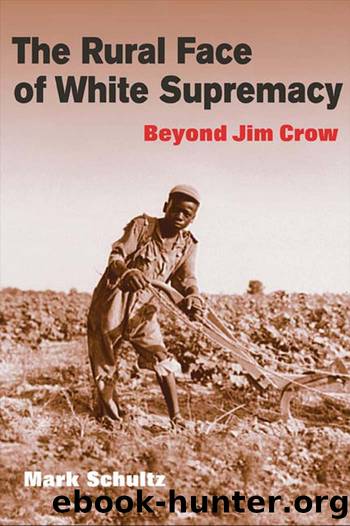The Rural Face of White Supremacy by Mark Roman Schultz

Author:Mark Roman Schultz
Language: eng
Format: epub
ISBN: 9780252092367
Publisher: University of Illinois Press
The Klan
Interestingly, the Ku Klux Klan, in its twentieth-century incarnations, kept a fairly low profile in Hancock County, likely because of the influence of these same Whiggish elites. Yet the Klan was not wholly absent there. It earlier had played a role during Reconstruction, when wholesale violence broke out against black people. A black state representative from Hancock, William H. Harrison, stated before Congress that more blacks were whipped after the Civil War than under slavery. Many others were murdered. In Hancock the Klan came to play a role in this violence, although most of the mayhem appeared diffuse and disorganized, the work of white men acting alone. In many counties white elites led the Klan, but in Hancock the aristocracy seems to have opposed the bloodshed and anarchy represented by the secret organization. When a Klan leader in a nearby county wrote his autobiography, he stated that the Democratic political leadership of Hancock had not been Klan dominated. He noted that Linton Stephens, an ex-Whig who orchestrated the bloodless coup that ultimately ended Reconstruction in Hancock in 1870, held a “prejudice” against the organization. Still, Hancock’s African Americans had much to fear from Klansmen from other counties, especially Warren County, to the north. One white man from Warren told Congress that the Klan had used threats of violence to force him to join. He also stated that Warren County Klansmen used to make expeditions to Hancock, a point corroborated by black Hancock sources.79
After Reconstruction the Klan died across the South. Then, in the 1910s and 1920s, white American Protestants reinvented the Klan to defend their provincial worlds against the perceived threats of modernization, including the increasing presence of women in the workforce; immigrants from eastern, central, and southern Europe; communists; Catholics; and African American veterans who had learned something about fighting and integration in France.80 The second Klan was founded in Georgia in 1915 and received a great recruiting boost from D. W. Griffith’s film Birth of a Nation, which exalted the Klan as the defender of white civilization against black “primitivism,” and especially of white womanhood against the “black rapist.”81 The film was not shown in Sparta’s movie theater, however. The nonappearance of the movie received little comment in the Sparta Ishmaelite, which had been under the sedate editorship of T. C. Moore since 1910. Nevertheless, the outspoken style of the previous editor, Sidney Lewis, in commenting on an earlier, stage version of the story reveals the conservative attitudes that held sway in Hancock. The movie was based on a novel by Thomas Dixon, The Clansman. In 1905 Dixon had rewritten the novel as a play that toured the country before packed houses almost everywhere—but not in places such as Hancock, where Lewis, writing in the Ishmaelite, called Dixon a “firebrand.” When the theatrical version of The Clansman launched on a second tour in 1906, Lewis warned his readers: “‘The Clansman’ is coming South again with Dixon, the fanatic, still shaking the red flag. The play will do infinite harm to our conditions in Georgia.
Download
This site does not store any files on its server. We only index and link to content provided by other sites. Please contact the content providers to delete copyright contents if any and email us, we'll remove relevant links or contents immediately.
| General | Discrimination & Racism |
Nudge - Improving Decisions about Health, Wealth, and Happiness by Thaler Sunstein(6657)
iGen by Jean M. Twenge(4714)
The Fire Next Time by James Baldwin(4364)
Adulting by Kelly Williams Brown(3700)
The Sports Rules Book by Human Kinetics(3611)
The Hacking of the American Mind by Robert H. Lustig(3597)
The Ethical Slut by Janet W. Hardy(3528)
Captivate by Vanessa Van Edwards(3319)
Mummy Knew by Lisa James(3179)
In a Sunburned Country by Bill Bryson(2962)
The Worm at the Core by Sheldon Solomon(2942)
Ants Among Elephants by Sujatha Gidla(2937)
Suicide: A Study in Sociology by Emile Durkheim(2620)
The Slow Fix: Solve Problems, Work Smarter, and Live Better In a World Addicted to Speed by Carl Honore(2582)
Humans of New York by Brandon Stanton(2387)
Handbook of Forensic Sociology and Psychology by Stephen J. Morewitz & Mark L. Goldstein(2383)
Blackwell Companion to Sociology, The by Judith R. Blau(2324)
The Happy Hooker by Xaviera Hollander(2279)
Outliers by Malcolm Gladwell(2270)
